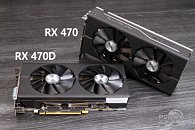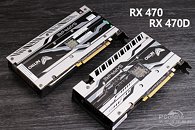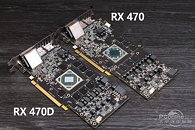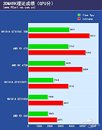Thursday, November 3rd 2016

Sapphire Radeon RX 470D NITRO Pictured, Beats GTX 1050 Ti
It turns out that the new SKU based on the Polaris 10 "Ellesmere" silicon AMD is working on, to fill the gap between the Radeon RX 460 and RX 470, could be named the "Radeon RX 470D," after all. It is also being reported that AMD is planning to launch this SKU only in China, for now. It is further cut down from the RX 470, in featuring 1,792 stream processors, by enabling just 28 out of 36 GCN compute units physically present on the chip. The SKU further features 112 TMUs, 32 ROPs, and 4 GB of GDDR5 memory across a 256-bit wide memory interface.
AMD is clocking the RX 470D slightly higher than the conventional RX 470. Its core ticks at speeds of up to 1266 MHz (Boost clock), and its memory at 7.00 GHz (GDDR5-effective), compared to the 1206 MHz (Boost clock) and 6.60 GHz (GDDR5-effective) speeds of the RX 470. The RX 470D will be built to a cost, and it shows, on the Sapphire RX 470D NITRO. The PCB is shorter, and the cooler leaner. Chinese tech publication PCOnline got its hands on a sample, and tested it to be faster than the GeForce GTX 1050 Ti, yet slower than the RX 470. The card is expected to be priced about 14 percent less than the RX 470. Find more benchmark figures in the PCOnline review linked below.
Sources:
PCOnline.com.cn, Videocardz
AMD is clocking the RX 470D slightly higher than the conventional RX 470. Its core ticks at speeds of up to 1266 MHz (Boost clock), and its memory at 7.00 GHz (GDDR5-effective), compared to the 1206 MHz (Boost clock) and 6.60 GHz (GDDR5-effective) speeds of the RX 470. The RX 470D will be built to a cost, and it shows, on the Sapphire RX 470D NITRO. The PCB is shorter, and the cooler leaner. Chinese tech publication PCOnline got its hands on a sample, and tested it to be faster than the GeForce GTX 1050 Ti, yet slower than the RX 470. The card is expected to be priced about 14 percent less than the RX 470. Find more benchmark figures in the PCOnline review linked below.





40 Comments on Sapphire Radeon RX 470D NITRO Pictured, Beats GTX 1050 Ti
Would have been better off dropping the price on the current RX 470
www.techpowerup.com/reviews/MSI/RX_480_Gaming_X/21.html
www.techpowerup.com/reviews/MSI/GTX_1050_Ti_Gaming_X/25.html
The Rx470 uses about 126W while the GTX 1050 Ti is at 75W, peak gaming. If the Rx470D is anything like the Rx470, the power difference is about 50W. If the Rx470D uses less power because it is slower overall than the non-D version, then that difference is going to be smaller than 50W.
I strongly suspect the VRM designs are not OEM suggested types (my 2nd idea above). I don't have an exact reference on the Rx-series of current, but when AMD introduced digital VRM controls, I think with the HD2900 series (featuring much higher frequency phases and surface mount tantalum polymer capacitors), none of the AIBs followed that trend with their custom cards. We frequently see these VRM design changes from digital to VRM since that time and if you check the prices, the digital parts are more expensive, as are the capacitors they use, in exchange you get better regulation and finger voltage controls and you can design a flatter-profile cooler that is very close to PCB height. During the HD4870 era, a lot of AMD's top notch cards had their digital VRMs damaged due to Furmark tests (was a big issue) and a lot of the AIBs marketed more robust VRM systems that used the older analog VRM designs.
www.newegg.com/Product/Product.aspx?Item=N82E16814137050
Dual fan RX 470 for $170.
\snarky
Yes the 470D will use more energy than a 1050 Ti, it is also incredibly more powerful.
Not that the difference in power usage in these cards matters at all. It's not like the situation with the GTX 480 vs 5870. Now THAT was pathetic.
But remember amd has 95w complete board and memory TDP figures for the rx480 based embedded solutions. They have only shown the tip of what Polaris can do. Unluckily it looks like glofo let them down again with a poor manufacturing process.
It's pretty obvious to me that the first Polaris samples were simply early junk yields that AMD was buying for bargain prices. 14nm was clearly a few months behind 16nm in maturation, and frankly it should be considering it is 9% more dense. But it's clear that the process is catching up, and we should see 100w 485's at 1400MHz+ very soon.
The lower wattage ones are the xfx they appear to have some preferential binning deal.